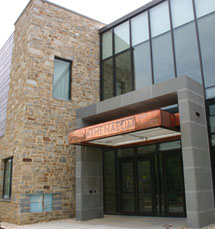Greening Our Buildings
Buildings in the United States are responsible for 39 percent of carbon dioxide emissions, 40 percent of energy consumption, 13 percent of water consumption, and 15 percent of gross domestic product per year, making “green” building a source of significant economic and environmental opportunity, according to the U.S. Green Building Council. Improved building efficiency can meet 85 percent of future U.S. demand for energy.
Goucher College has recognized the benefits of incorporating sustainable design principles into its facilities planning and has begun to build and renovate in a more environmentally conscious way.
Silver LEED Rating Policy
Goucher passed a policy in 2009 that ensures all new buildings or major renovations to existing buildings are planned with the goal of achieving at least a Silver rating according to the US. Green Building Council’s LEED (Leadership in Energy and Environmental Design) Green-Building Rating System.
The LEED rating system offers four certification levels for new construction - Certified, Silver, Gold, and Platinum - that correspond to the number of credits accrued in five green design categories: sustainable sites, water efficiency, energy and atmosphere, materials and resources, and indoor environmental quality.
The Athenaeum
 The Athenaeum, completed in September 2009, is Goucher’s first Gold-certified new
building. It is the new centerpiece of Goucher’s campus, weaving together the various
threads of life at the college in one signature building — a physical centerpiece
for the campus that also is the figurative heart of the academic community.
The Athenaeum, completed in September 2009, is Goucher’s first Gold-certified new
building. It is the new centerpiece of Goucher’s campus, weaving together the various
threads of life at the college in one signature building — a physical centerpiece
for the campus that also is the figurative heart of the academic community.
The 103,000-square-foot building is open 24 hours a day and features a new, technologically superior library; a spacious open forum for performances, public discussions, and other events; a café, art gallery; a center for community service and multicultural affairs programming; and spaces for exercise, conversation, and quiet reflection and relaxation.
Goucher, in collaboration with the architecture firm RMJM, approached every aspect of the Athenaeum project with an eye toward sustainable design strategies.
The Athenaeum employs energy-saving features, such as high-performance insulated glass that admits daylight while reducing heat gain, solar water heating, light-activated motorized window shades, motion sensors for lighting, and displacement ventilation. The building incorporates recycled building materials, low volatile organic compound adhesives and sealants, a system zoning control of the HVAC and lighting systems for maximum efficiency, and two “green” roofs that reduce heat gain and alleviate stormwater runoff. The building’s water conservation features include dual-flush toilets, waterless urinals, water-efficient landscaping, and motion-activated faucets.
The Athenaeum was an integral part of the Strategic Plan that Goucher adopted in 2002. Construction on the building began in May 2007, with the final cost totaling $48 million. Only one other higher educational institution in Maryland has been awarded Gold LEED status.
Past Renovation Projects
- Motion-detecting sensors have been interfaced with both the lighting and heating and cooling systems in Van Meter Hall. Most of the lights in the laundry and trash rooms in the residence halls operate via motion-detecting sensors. The sensors have also been added to all the campus’s vending machines to conserve energy when not in use. The college is integrating the sensors into the lighting systems in other buildings.
- All the low-flow showerheads in the residence halls have been replaced with ultra-low-flow showerheads. The new shower heads provide a better quality shower while saving 4,400 gallons of hot water a day.
- Paper towel dispensers were replaced by powerful energy-efficient automatic hand dryers on campus. The Sports and Recreation Center was the first building to be outfitted.
